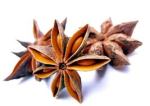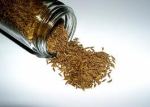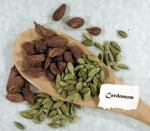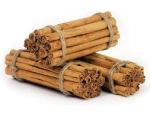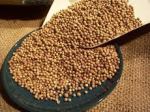Herb and Spice Research Indicates that the foods you eat can make or break your health! The latest research shows that many diseases can be stopped and /or reversed by changing the food you eat, especially using healing herbs and spices.
Your health is in your hands. It can be in your kitchen.
What's more, according recent scientific research, some herbs and spices have the ability to help neutralize harmful substances in the body, taking away their cancer-causing potential. Nutmeg, ginger, cumin, black pepper and coriander, for example, have been shown to help block the effects of aflatoxin, a mold that can cause liver cancer.
Recent studies show that many spices used in ancient times for healing are as relevant for healing today as they were then.
Your health is in your hands. It can be in your kitchen.
What's more, according recent scientific research, some herbs and spices have the ability to help neutralize harmful substances in the body, taking away their cancer-causing potential. Nutmeg, ginger, cumin, black pepper and coriander, for example, have been shown to help block the effects of aflatoxin, a mold that can cause liver cancer.
Recent studies show that many spices used in ancient times for healing are as relevant for healing today as they were then.
Cayenne
That burning sensation in your mouth when you eat foods spiced with cayenne (red) pepper comes from capsaicin, the oily compound behind most of the health benefits of cayenne and its peppery cousins. Capsaicin is the active ingredient in many prescription and over-the-counter creams, ointments, and patches for arthritis and muscle pain. Over time, it short-circuits pain by depleting nerve cells of a chemical called substance P, which helps transfer pain signals along nerve endings to the brain. It's also used for treating shingles pain and diabetes-related nerve pain.
Cayenne's benefits don't end there, however. Sprinkle some onto your chicken soup to turbocharge that traditional cold remedy, since cayenne shrinks blood vessels in your nose and throat, relieving congestion. It's also a metabolism booster, speeding up your calorie-burning furnace for a couple of hours after eating. Cayenne is thought to act as an anti-inflammatory and antioxidant. Studies find that it also has some anticancer properties, and researchers are exploring its potential as a cancer treatment. Finally, in at least one study, published in the American Journal of Clinical Nutrition, researchers found that people with diabetes who ate a meal containing liberal amounts of chile pepper required less postmeal insulin to reduce their blood sugar, suggesting the spice may have antidiabetes benefits.
Cinnamon
Cinnamon on toast or oatmeal is so tasty it's hard to believe the brown powder has any health benefits at all, but it's actually one of the most powerful healing spices. It's become most famous for its ability to improve blood sugar control in people with diabetes. Some of its natural compounds improve insulin function, significantly lowering blood sugar with as little as 1/4 to 1/2 teaspoon a day. The same amount could cut triglycerides and total cholesterol levels by 12 to 30 percent. The apple pie spice can even help prevent blood clots, making it especially heart smart.
Like many other spices, cinnamon has antibacterial and anti-inflammatory properties. It's been shown to conquer E. coli, among other types of bacteria. Researchers have even discovered recently that it's rich in antioxidants called polyphenols - another reason it's good for your heart. It's also high in fiber (after all, it comes from the bark of a tree) and can reduce heartburn in some people.
Cloves
Cloves, an aromatic spice common in Indian cooking, contain an anti-inflammatory chemical called eugenol. In recent animal studies, this chemical inhibited COX-2, a protein that spurs inflammation (the same protein that so-called COX-2 inhibitor drugs such as Celebrex). Cloves also ranked very high in antioxidant properties in one study. The combination of anti-inflammatory and antioxidant properties spells heaps of health benefits, from boosting protection from heart disease to helping stave off cancer, as well as slowing the cartilage and bone damage caused by arthritis. Compounds in cloves, like those found in cinnamon, also appear to improve insulin function.
Have a toothache? Put a couple of whole cloves in your mouth. Let them soften a bit, then bite on them gently with good molars to release their oil. Then move them next to the painful tooth and keep them there for up to half an hour. Clove oil has a numbing effect in addition to bacteria-fighting powers. In test tubes, cloves also killed certain bacteria that were resistant to antibiotics.
Coriander
Coriander seeds yield cilantro, also known as Chinese parsley, a staple herb in Mexican, Thai, Vietnamese, and Indian cooking. The seeds have been used for thousands of years as a digestive aid. Try making a strong tea from crushed seeds (strain before drinking). The herb can be helpful for some people with irritable bowel syndrome, as it calms intestinal spasms that can lead to diarrhea. Preliminary studies in animals support another traditional use for coriander - as an antianxiety herb. Its essential oil appears to fight bacteria, including E. coli and salmonella. It's also being studied for its potential cholesterol-reducing benefits and has been shown to lower cholesterol in animals.Like many other herbs, this one acts as an antioxidant. According to one study, cilantro leaves provide the most antioxidant punch
Garlic
Smash a clove of garlic and take in the pungent fragrance. That famous odor comes from byproducts of allicin, the sulfur compound believed to be responsible for most of the herb's medicinal benefits. It's what gives garlic its 'bite.'
When eaten daily, garlic can help lower heart disease risk by as much as 76 percent. How? By moderately reducing cholesterol levels (by between 5 and 10 percent in some studies), by thinning the blood and thereby staving off dangerous clots, and by acting as an antioxidant. Garlic's sulfur compounds also appear to ward off cancer, especially stomach and colorectal cancer. The compounds flush out carcinogens before they can damage cell DNA, and they force cancer cells that do develop to self-destruct.
Strongly antibacterial and antifungal, garlic can help with yeast infections, some sinus infections, and the common cold. It can even repel ticks (as well as friends and family, if you eat enough).
Ginger
This gnarled root has been a major player in Asian and Indian medicine for centuries, primarily as a digestive aid. Today researchers are most excited by ginger's ability to combat inflammation. Several studies have found that ginger (and turmeric) reduces pain and swelling in people with arthritis. It may work against migraines by blocking inflammatory substances called prostaglandins. And because it reduces inflammation, it may also play a role in preventing and slowing the growth of cancer.
Ginger's still good for the tummy, too. It works in the digestive tract, boosting digestive juices and neutralizing acids as well as reducing intestinal contractions. It's proven quite effective against nausea. In fact, at least one study found ginger to work just as well as Dramamine (dimenhydrinate) and other nausea-stopping drugs, with the added benefit that it doesn't make you sleepy. The trick is to take ginger (in tablet, powder, or natural form) before you think you may become nauseated, when it works best. It's also an effective, short-term treatment for morning sickness.
Mustard
Mustard is made from the seeds of a plant in the cabbage family - a strongly anticancer group of plants. Indeed, mustard seeds contain compounds that studies suggest may inhibit the growth of cancer cells.
Mustard also packs enough heat to break up congestion, the reason it was traditionally used in chest plasters. Like cayenne pepper, it has the ability to deplete nerve cells of substance P, a chemical that transmits pain signals to the brain, when used externally. A mustard compress also brings more blood to the fingers of people with Raynaud's phenomenon, a circulatory problem that causes frigid fingers.
Mustard is also said to stimulate appetite by increasing the flow of saliva and digestive juices. A bit of mustard powder added to a foot bath helps kill athlete's foot fungus. *Don't eat too many mustard seeds or more than a teaspoon of mustard powder; the former has a strong laxative effect, while the latter can induce vomiting.
Nutmeg
Like cloves, nutmeg contains eugenol, a compound that may benefit the heart. It was one of the key spices that give the Spice Islands their name, and some historians link its popularity in the spice trade to the hallucinatory effects that result from ingesting large amounts. The euphoria, which is due to nutmeg's active ingredient, myristicin, is described as similar to that caused by the drug ecstasy. Don't worry about your teens raiding your spice drawer for a quick high, however; it also packs some nasty side effects, and nutmeg poisoning is a very real risk.
Medically, nutmeg (the seed of an evergreen tree) and mace (the covering of the seed) have strong antibacterial properties. It's been found to kill a number of bacteria in the mouth that contribute to cavities. Myristicin has also been shown to inhibit an enzyme in the brain that contributes to Alzheimer's disease and to improve memory in mice, and researchers are currently studying its potential as an antidepressant.
Sage
Perhaps it's no coincidence that 'sage' describes a wise person; the herb is a known memory enhancer and has been shown in some lab studies to protect the brain against certain processes that lead to Alzheimer's disease. In at least one human study, a sage-oil concoction improved the mood of participants, increasing their alertness, calmness, and contentedness. In a British study, healthy young adults performed better on word recall tests after taking sage-oil capsules.
Like so many other herbs and spices, sage has anti-inflammatory and antioxidant properties as well as anticancer actions. One of its phytochemicals is thujone, best known as a chemical in the liquor absinthe that is said (falsely) to have hallucinatory effects. Today sage shows potential as a diabetes treatment. It appears to boost the action of insulin and reduce blood sugar. As a result, sage is sometimes called nature's metformin since it performs like the common antidiabetes drug. Some researchers have already suggested that sage supplements may help prevent type 2 diabetes.
Turmeric, the spice that gives curry powder its yellow hue, is used in Indian medicine to stimulate the appetite and as a digestive aid. But lately it's grabbing some serious attention as a potentially powerful cancer fighter. The chemical responsible for turmeric's golden color, called curcumin, is considered a top anticancer agent, helping to quell the inflammation that contributes to tumor growth and working in much the same way as broccoli and cauliflower to clear carcinogens away before they can damage cellular DNA and to repair already damaged DNA. Lab studies show turmeric helps stop the growth and spread of cancer cells that do form. Research suggests that it may protect against colon cancer as well as melanoma, the deadliest form of skin cancer. Researchers at Rutgers University in New Jersey are investigating a combination of curcumin and phenethyl isothiocyanate (the anticancer compound in cruciferous vegetables) as a possible treatment for prostate cancer.
Studies have also linked turmeric to reduced inflammation in a number of conditions, including psoriasis. In animal studies, curcumin decreased the formation of amyloid, the stuff that makes up the brain deposits characteristic in people with Alzheimer's disease.





